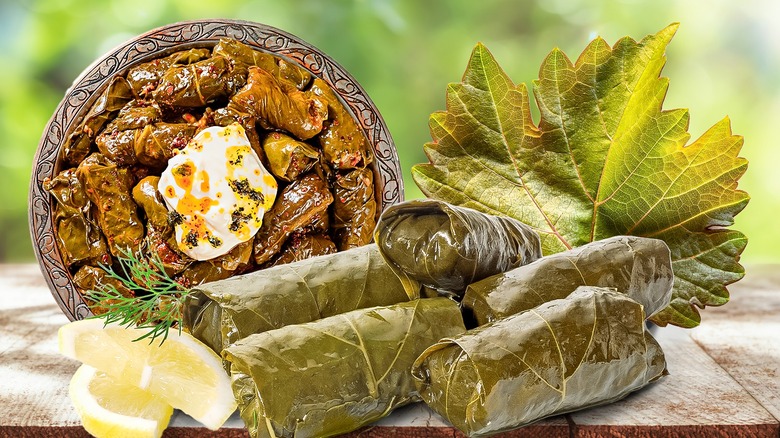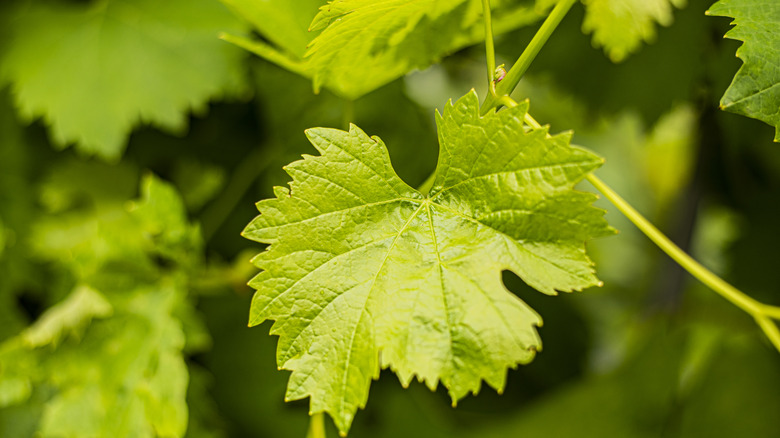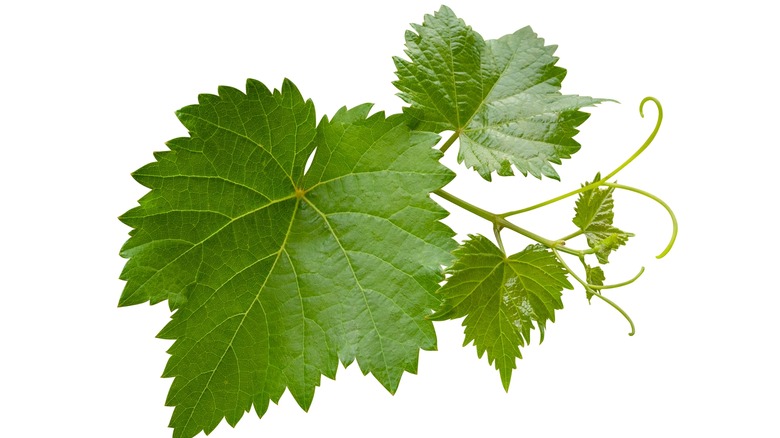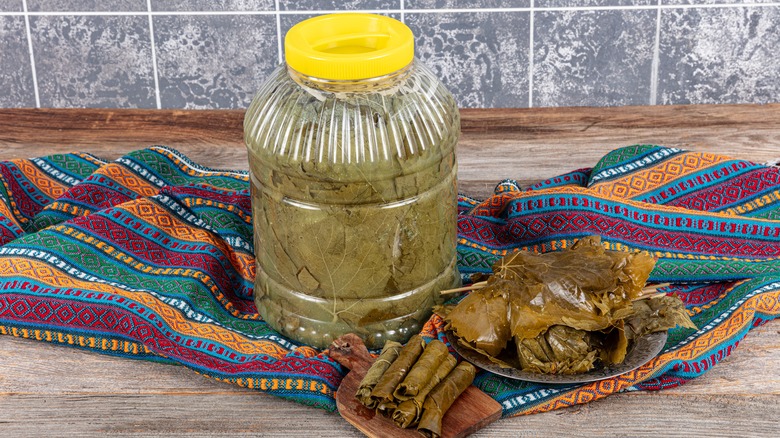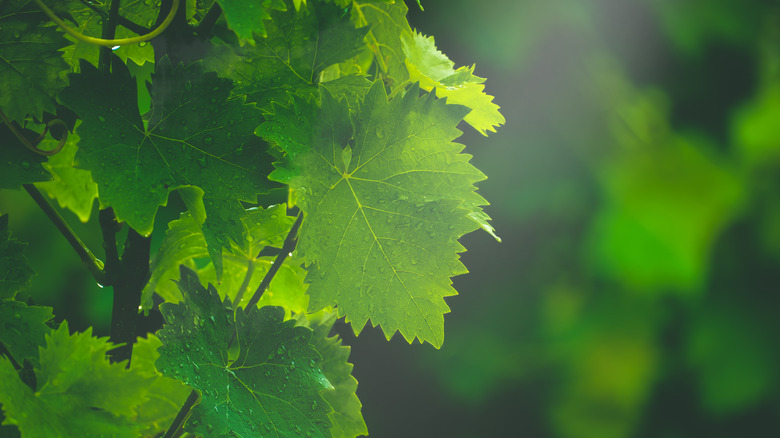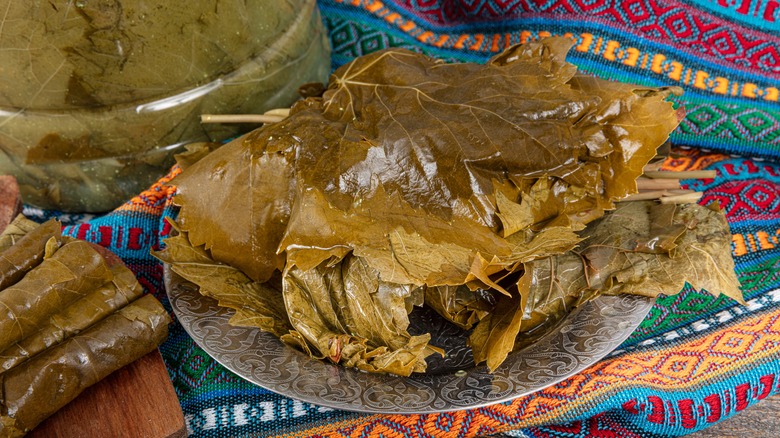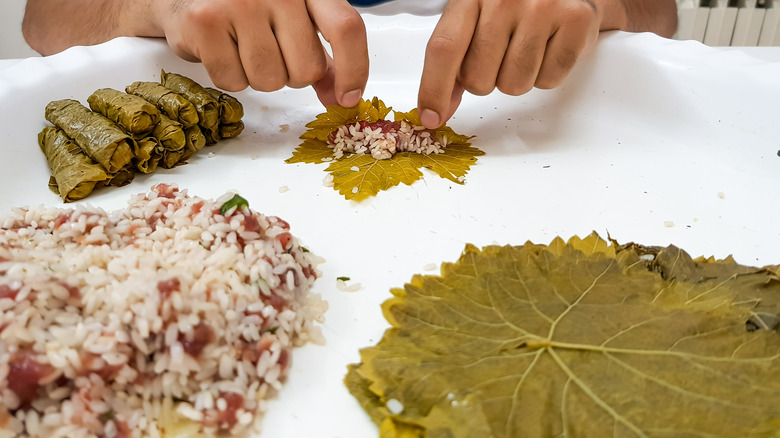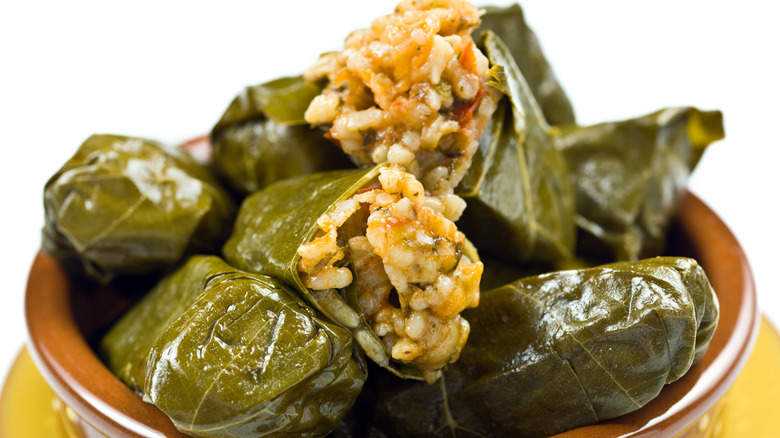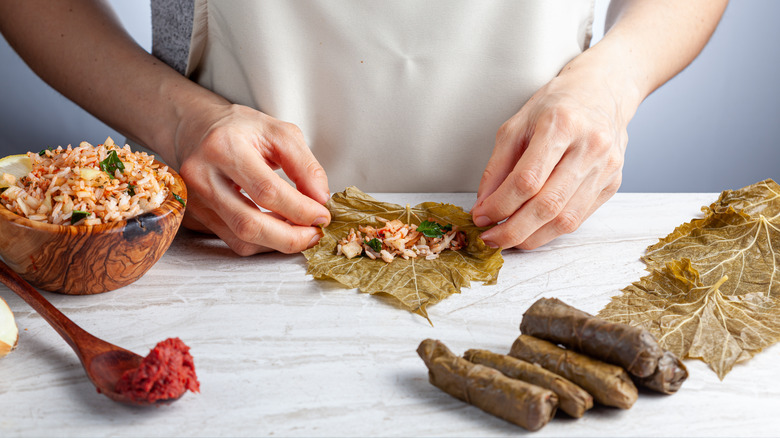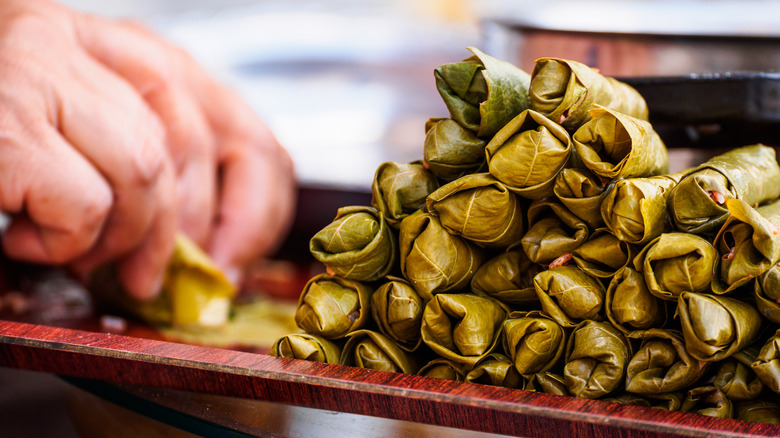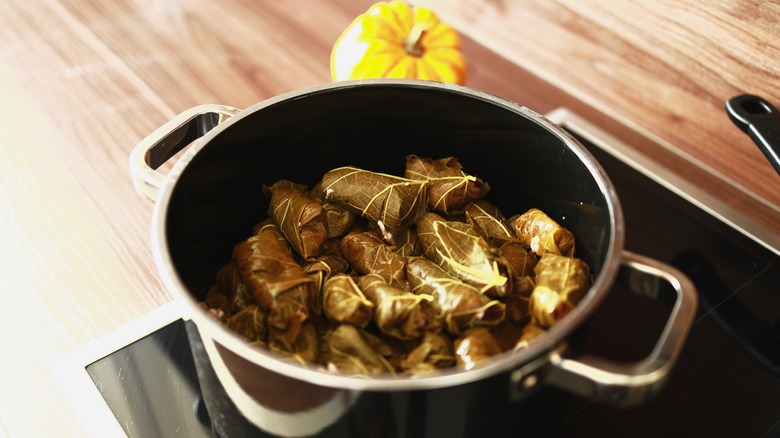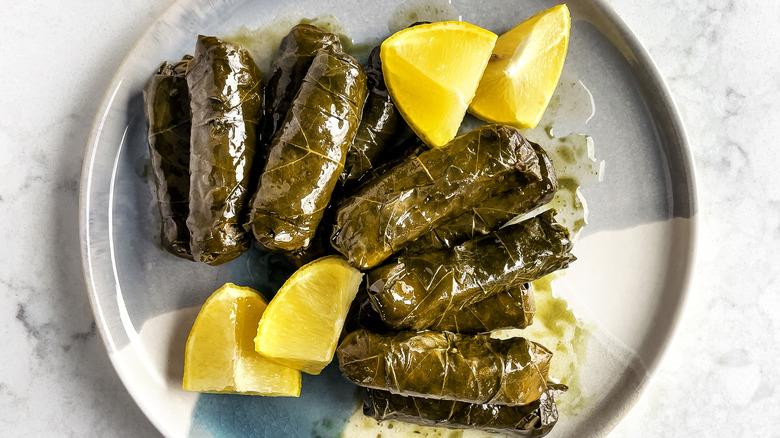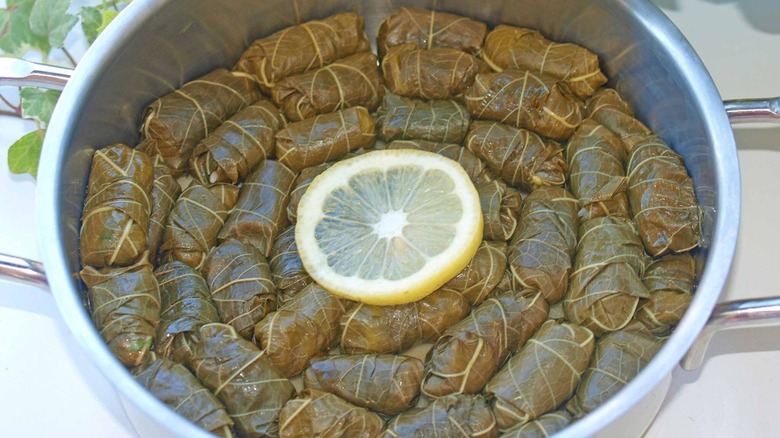12 Tips For Cooking With Grape Leaves
Grape leaves aren't a typical pantry item or farmer's market purchase for most Americans, which is a real shame. After all, these leaves — which grow abundantly along vineyards and often end up as plant waste — are both edible and incredibly delicious. For cultures that hail from the Balkans, Turkey, Lebanon, or North Africa (and beyond), grape leaves are beloved for their part in a dish that goes by many names, including dolmas, dolmades, and warak enab. In fact, "dolma" is the Turkish word for "stuffed" or "filled" — which is what these leaves are mainly used for.
Sturdy enough to hold a filling but soft enough to make eating them pleasant, grape leaves make the perfect vessel for stuffing. Grape leaves also absorb flavor really well, which can be imparted when cooking them in broth (or even just some lemon juice and olive oil). Of course, since there are different methods for cooking stuffed grape leaves, some may find the ingredient intimidating at first.
However, once you understand how to use grape leaves, they'll become totally demystified — and you can even get creative beyond dolmas. Growing up in an Egyptian household, I cooked extensively with grape leaves (both fresh and jarred) and have rolled my fair share of dolmas or warak enab (as we called them). Here are some tips to keep in mind cooking with grape leaves.
Use fresh leaves if you have the option
Unless you're in the Middle East or Greece, it's pretty rare to find fresh grape leaves. Even if you're in wine country, it's not a commonly sold food product. However, if you do somehow manage to get your hands on some? Take the opportunity, because fresh leaves are going to be naturally tastier and more vibrant than preserved grape leaves in a jar or can.
Not only are fresh grape leaves the better-tasting option, but they're easier to work with, too. You won't need to do the extra steps to remove the brine like you would with preserved leaves. Plus, fresh leaves are generally more tender if you pick the right ones. While they can be extremely difficult to find in the U.S., try asking about fresh grape leaves at your local's farmer's market, or when visiting a vineyard. It never hurts to ask (and I've gotten lucky a few times this way!).
Now, if you can't find fresh leaves, don't despair. You can still use canned or jarred leaves for any occasion when fresh ones aren't available. Preserved grape leaves come in a close second to fresh leaves, after all. You can even find canned dolmas, and it's worth keeping stuffed grape leaves in your pantry for when you want a quick and easy snack.
When picking leaves, look for smaller and younger ones
As delicious as stuffed grape leaves are to eat, there's nothing worse than biting into a tough leaf. They're harder to chew and often stay in your mouth long after you've swallowed the filling. Simply put, whether you're picking leaves directly off the vine, choosing some to buy from a vendor, or selecting the best ones out of a jar, some leaves are better to use than others. While there's no real harm in using any type of grape leaf, younger leaves tend to be more tender — meaning they're the better option to cook and eat.
Younger grape leaves are often slightly smaller and have less visible veins. Since the veins are what makes it more difficult to chew (and are the pieces most likely to get stuck in your mouth and teeth), it's always better to cook with leaves where these are thinner and less protruding.
Now, larger — and, therefore, older — grape leaves can still work, but they'll need more time to cook. This can throw the whole dish off, of course, so it's worth searching for smaller options. Then again, don't discard larger leaves, as they can come in handy (more on that later).
Always rinse your jarred grape leaves before preparing
There's a lot of convenience to be found with jarred or canned grape leaves. They're already washed and trimmed, plus you don't need to boil them as long beforehand to tenderize them. Yet one mistake people often make is thinking these grape leaves are completely ready — and don't need to be rinsed. Though canned and jarred grape leaves are technically ready to eat as is, they're often overly salty from the brine, and may have a little bit of a metallic, can-like taste. Consequently, be sure to rinse off preserved grape leaves before stuffing them.
Now, you don't need to thoroughly wash these grape leaves the way you might with fresh produce. Rather, you simply want to rinse them enough so the brine has been completely washed away. Remove all the leaves you're using from the jar or can and straighten them out (they're sometimes rolled up). Place them in a bowl and submerge them in water. After this, toss out the water before repeating the process at least once more, and your leaves should be good to go.
Along those lines, you need to rinse canned dolmas before eating them, too (even though they're already stuffed and rolled). You'll need to take a little more care not to unravel them, but it's still best to give them a light soak to reduce the saltiness.
Boil fresh leaves before using
Given how incredible fresh grape leaves are, if you've managed to get your hands on a batch, you'll want to take some specific steps during the preparation process. While it can be rewarding to cook with fresh grape leaves, remember they'll need more cooking time than preserved ones. In fact, whatever you're cooking inside it won't take as long to cook as the fresh leaf, so you'll want to par-boil the leaves before assembling your dish.
Partially boiling fresh grape leaves is a good way to avoid overcooked fillings. Once you've thoroughly washed the leaves, bring a pot of water to a roiling boil, before placing the leaves into the pot one at a time. Don't have the heat up too high, as you only want to partially cook the leaves. If you boil them for too long, they can disintegrate and become incapable of holding their shape or any fillings. You can also help tenderize fresh leaves by adding 1 tablespoon of vinegar to the boiling water.
Additionally, you'll know when to remove the grape leaves from the water, as their color turns from bright green to a yellowish green. Remove them with a strainer or colander and allow the leaves to cool before stuffing and rolling them.
Blanch jarred or canned grape leaves
Grape leaves out of a jar or can are likely to be completely soaked in brine. In fact, even if you rinse these leaves thoroughly, the finished product may still be too salty for your liking. This is because rinsing will only get rid of the excess brine on the outside of the leaves, but not the brine they absorbed during the preservation process. Thankfully, there's an additional step to help further reduce the amount of brine (and salt) in these leaves: blanching them in boiling water.
Blanching is a relatively easy thing to do – and just a couple of minutes does the trick in my experience. The hot water helps draw out additional salt from deep within the leaves, making them more of a blank slate for the other flavors you're using. And considering dolma is a labor of love, this step is well worth it. You don't want to go through all that effort for a final product that tastes lackluster, after all.
The best time to blanch preserved grape leaves is right before you're ready to use them. Start by preparing a pot of boiling water and a bowl full of ice water. Place your leaves in the boiling water for about two minutes, then carefully remove them. Next, place the leaves into the ice water so they cool down completely and instantly stop cooking. After this, you can drain them, pat them dry, and get rolling.
Organize and prep your leaves first
Making stuffed or rolled grape leaves is a little bit of a process. Given this, it's always best to be organized and prep your leaves ahead of time so everything is ready for you to roll without interruption.
First, make sure you cut off the stem from each leaf. This little piece doesn't serve any purpose in your dish and can even be chewy and unpleasant. Use a small, sharp pair of scissors and cut the stem where it meets the leaf. Avoid trying to use a knife or tugging at it to remove it, because you might end up tearing the leaf unnecessarily. The most important thing to keep in mind when working with grape leaves is to treat them with care. You want to prevent any tearing or breaking, after all, so be as delicate as possible when handling them.
Additionally, it's best to straighten out your grape leaves and stack them neatly. The worst thing you can do is keep the leaves in a bowl in a disorganized way, as this can quickly become an obstacle each time you reach for a new leaf. Stacking them flat in piles on a surface in front of you will make it easier to create a kind of production line, allowing you to easily grab, fill, and roll up each leaf.
Season and taste your filling
When cooking with grape leaves, it's easy to give them all of your attention. After all, a lot of focus is spent on making sure the leaves are rinsed, blanched, and prepped to roll seamlessly. However, if you do everything correctly with your grape leaves, but neglect to get your filling right? You'll end up with an average tasting dolma as a result.
A big reason why stuffed grape leaves are so delightful (and worth making) is the delicious filling. In other words, whether you're making a traditional dolma rice filling or making up your own recipe, you'll want to be sure you season the filling properly. Frankly, it's hard to fix under seasoned dolmas after they've finished cooking, so getting everything right before rolling the leaves is key.
Now, the easiest way to ensure your filling is tasty and properly seasoned is to taste it while you cook. In fact, even if you're making a rice-based stuffing (and don't necessarily want to be chewing on hard, undercooked rice), it's important to try it as you cook. That way, you'll be able to adjust the seasonings, spices, and other ingredients to your liking.
Add the filling on the back, veiny side of the leaves
Once the filling you've prepared is ready to be placed in the middle of a leaf, you come to the fun (if slightly tricky) part: rolling the grape leaves. This is the main event, of course, and there are different techniques for this process. One of the most important things to remember is to add the filling on the backside of the leaf rather than the front. This is the rougher side where the veins protrude, so keeping it on the inside will make your dolmas more appealing (and pleasant to eat) by leaving the smooth, softer side on the exterior.
To do the actual rolling, you can either fold over the left and right side of the leaf then roll it up, or simply roll from the bottom upwards (tucking in the sides as you go). You can also use plastic wrap to help you roll your grape leaves if you're so inclined. Additionally, it may be beneficial to watch some videos online to help you visualize how to roll and tuck. Whatever you end up doing should feel intuitive, though, since you're going to be doing a lot of the same motion.
Don't overstuff your grape leaves
Whether you're stuffing your grape leaves with a rice mixture or not, it's best not to add too much. Smaller dolmas are easier to pick up without trouble, and the ratio of grape leaf to filling won't be as disproportionate. This is crucial, of course, because with too much filling, you won't get to taste the grape leaves as well. This is especially important with a rice filling since the rice is usually only par-cooked, and likely to expand further inside the grape leaves (potentially dominating the dish).
Now, how much filling is too much depends on preference. Some people enjoy thicker dolmas, and some prefer them to be as thin as a finger. It's always good to start with roughly 1 teaspoon of filling, then see if you want to add more after rolling it. Additionally, there needs to be a little bit of leeway for the rice expansion to take place, so don't roll them too tightly.
It's also not completely unheard of to use fully cooked rice when making stuffed grape leaves. If you don't want to do all the guesswork required in partially cooking it, you can use fully cooked rice (and it's a great way to use up leftover rice). Just make sure you precook the leaves a bit longer in this scenario, as well, so you don't end up with a complete mush as your filling.
Cook with stock for extra flavor
Once you've rolled your grape leaves and they're ready to be cooked, there's one last way to impart additional flavor. Instead of just cooking them in water, use stock instead. The leaves and filling will absorb the liquid as they cook, so the more flavor your stock has, the more delicious your dolmas will be. You can use any type of stock, including a dried cube or powder variety. Give it a taste beforehand, though; you may need to adjust the salt level or add other spices and seasonings.
There's also a way to make your own flavorful broth by adding simple ingredients to your cooking water, such as olive oil, salt, and lemon juice. Other recipes might call for using a tomato-based sauce, or even just some slices of fresh tomatoes and onions. All of these are great ways to get your grape leaves tasting extra yummy.
Use larger leaves as a protective layer
It's always better to use younger grape leaves because they're more tender and easier to cook. However, jars of grape leaves come with leaves of all sizes, and you're even likely to find some damaged ones, too. To prevent food waste — and because these leaves are useful for another purpose — it's worth hanging on to them. Instead of discarding any larger or damaged and torn leaves, use them as a protective layer between the pot and your dolmas when cooking.
People in my family have used this technique for generations (from my grandmother's grandmother down to me) as it creates a natural barrier that prevents the dolmas from sticking. You can stack a few layers to cover up any holes, as well, but be sure you rinse and blanch these leaves along with the rest so they're not full of brine. Once ready, straighten them out and lay them at the bottom of your pot, then proceed to add your rolled up grape leaves on top.
Cover your stuffed leaves with something heavy while cooking
Once you've seamlessly rolled your grape leaves into little stuffed parcels and neatly laid them in the pot, they're ready to be cooked. However, if you just add broth, turn up the heat, and expect things to turn out great, you may end up noticing your dolmas floating in the broth and beginning to unravel (the horror!). You don't need to worry about this happening, though, as there's an easy (and essential) way to prevent this occurrence: cover your stuffed grape leaves with something heavy so they remain in the bottom of the pot.
You can simply use a large plate, or even a smaller one with a bowl of water to keep the dolmas from floating up. Realistically, it depends on the size of your cooking vessel. With that in mind, be sure the plate is substantial enough to cover and weigh down your dolma while still being able to close the pot's lid. Otherwise, you risk the unraveling of all your hard work, and improperly cooking your stuffed grape leaves.
